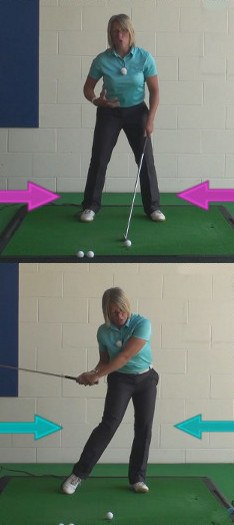
Footwork plays a vital role during the golf swing as the feet provide the base for balance and stability during your movement.
At set up, your feet should be shoulder width apart and balanced, with equal weight on both your left and right foot, plus equal weight between your toes and heels. During the backswing, the feet remain very stable and balanced. More weight should be placed on to your right foot by the top of your backswing, approximately 60%, but the weight remains balanced between your toes and heels. Ensure that your foot remains flat and stable to the floor and that it resists rolling over slightly to the outside of your foot or back on to your heel.
From this position the feet instigate the downswing. You should begin to push your weight off and rotate from your right foot on to your left, rotating your right foot on to it's instep, so that at impact your right heel is raised from the ground, your weight is on the instep of your right foot and 70% on your left foot. Your left foot remains flat to the floor, completely in the position that it began, with no rotation whatsoever, however your weight should feel more towards the heel of your left foot now as your body above is rotating left.
Following impact, your right foot continues to rotate towards the target and finishes with your shoelaces facing the target and only the very toe of your shoe in contact with the floor. 90% of your weight has now moved on to your left foot which has remained stable, balanced, flat to the floor and still in the position that it started.
If you struggle to achieve a left foot position that finishes in the same position that it began the swing in, then try placing a ball outside your left toes and inside your left heel. Make a golf swing and work on not moving either of the balls to ensure a more stable left foot position.
Using the correct footwork during your golf swing will provide you with more balance throughout the movement and a more powerful and accurate swing as your weight transfers more correctly.






